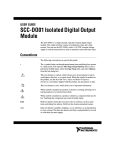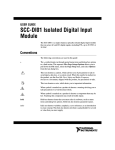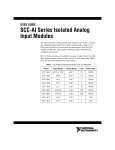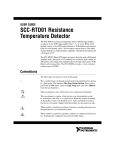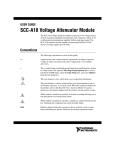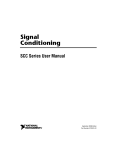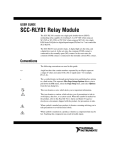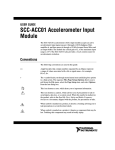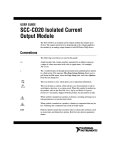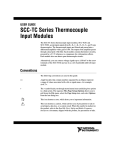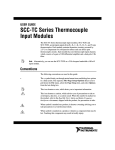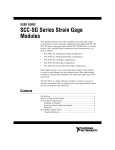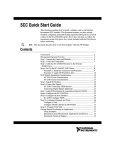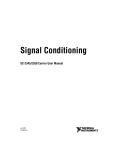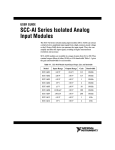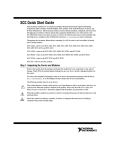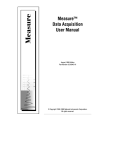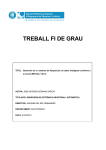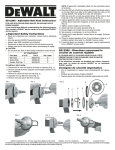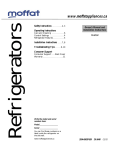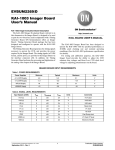Download Manual - National Instruments
Transcript
USER GUIDE SCC-FV01 Frequency Input Module The SCC-FV01 frequency input module is a frequency-to-voltage converter designed to measure signals from frequency-generating sensors and other periodic signal sources. The DC output voltage of the module is proportional to the input frequency. Conventions The following conventions are used in this guide: <> Angle brackets that contain numbers separated by an ellipsis represent a range of values associated with a bit or signal name—for example, P1.<3..0>. » The » symbol leads you through nested menu items and dialog box options to a final action. The sequence File»Page Setup»Options directs you to pull down the File menu, select the Page Setup item, and select Options from the last dialog box. This icon denotes a note, which alerts you to important information. This icon denotes a caution, which advises you of precautions to take to avoid injury, data loss, or a system crash. When this symbol is marked on the product, refer to the Read Me First: Safety and Radio-Frequency Interference document, shipped with the product, for precautions to take. When symbol is marked on a product, it denotes a warning advising you to take precautions to avoid electrical shock. When symbol is marked on a product, it denotes a component that may be hot. Touching this component may result in bodily injury. bold Bold text denotes items that you must select in software, such as menu items and dialog box options. Bold text also denotes parameter names. italic Italic text denotes variables, emphasis, a cross reference, or an introduction to a key concept. This font also denotes text that is a placeholder for a word or value that you must supply. monospace Text in this font denotes text or characters that you should enter from the keyboard, sections of code, programming examples, and syntax examples. This font is also used for the proper names of disk drives, paths, directories, programs, subprograms, subroutines, device names, functions, operations, variables, filenames, and extensions. SC-2345 SC-2345 refers to both the SC-2345 connector block and the SC-2345 configurable connector. SCC SCC refers to any SCC Series signal conditioning module. What You Need to Get Started To set up and use the SCC-FV01, you need the following items: ❑ SC-2345/2350 with one of the following: – SCC-PWR01 – SCC-PWR02 and the PS01 power supply – SCC-PWR03—requires a 7 to 42 VDC power supply (not included) ❑ One or more SCC-FV01 ❑ SCC-FV01 Frequency Input Module User Guide ❑ SC-2345/2350 User Manual, available at ni.com ❑ SCC Quick Start Guide, available at ni.com ❑ Read Me First: Safety and Radio-Frequency Interference ❑ SC-2345 Quick Reference Label ❑ 68-pin E Series DAQ device, documentation, and 68-pin cable ❑ 1/8 in. flathead screwdriver ❑ Numbers 1 and 2 Phillips-head screwdrivers ❑ Wire insulation strippers ❑ NI-DAQ (current version) for Windows 2000/NT/XP/Me SCC-FV01 Frequency Input Module User Guide 2 ni.com Software scaling of measurements is not supported on the Macintosh operating system. Refer to the SCC-FV01 Module Pin Assignments section for more information. Note Device Specific Information For general SCC module installation and signal connection information, and information about the SC-2350 carrier, refer to the SCC Quick Start Guide, available for download at ni.com/manuals. Note Installing the Module Caution Refer to the Read Me First: Safety and Radio-Frequency Interference document before removing equipment covers or connecting/disconnecting any signal wires. You can plug the SCC-FV01 into any analog input socket on the SC-2345. It can function as a single-stage analog input or as the second stage of a dual-stage analog input configuration. The socket you choose determines which E Series DAQ device channels receive the SCC-FV01 signals, as explained in the Connecting the Input Signals section. For single-stage input conditioning, plug the SCC-FV01 into any socket J(X+1), where X is 0 to 7, and connect the input-signal wires to the module as described in the Connecting the Input Signals section. If you use the SCC-FV01 in a dual-stage configuration, you must use it as the second stage. Plug the first-stage module into any socket J(X+9) and plug the SCC-FV01 into socket J(X+1), where X is 0 to 7. Note Sockets J9 to J16 are also available for digital input/output conditioning or control. Refer to the SC-2345 User Manual for more information on configuring, connecting, and installing SCC modules. Connecting the Input Signals The signal names have changed. Refer to ni.com/info and enter rdtntg to confirm the signal names. Note ❑ Each screw terminal is labeled by pin number <1..4>. The SCC-FV01 has two referenced single-ended (RSE) input channels. Pins 1 and 2 form a channel routed to E Series DAQ device channel X+8, and pins 3 and 4 form a second channel routed to E Series DAQ device channel X. The value of X is determined by the number of the SC-2345 socket where you plug in the module, J(X+1) or J(X+9). Both input channels are referenced to AI GND of the E Series DAQ device. © National Instruments Corporation 3 SCC-FV01 Frequency Input Module User Guide If your application requires nonreferenced inputs, consider using an SCC-AI Series module as the first stage in a dual-stage configuration. Note For information about how to configure the SCC-FV01 module using NI-DAQmx, refer to the SCC Quick Start Guide. Using the SCC-FV01 Scaling Voltage Measurements If you configured the SCC-FV01 using Measurement & Automation Explorer (MAX) and you are using NI-DAQ, the reading you get from the E Series DAQ device is properly scaled. Otherwise, you must scale your readings by multiplying the measured DC voltage by 10 to get the input frequency in hertz. Measuring Frequencies Below 5 Hz The output ripple of the SCC-FV01 increases as the input frequency decreases, and it is significant for frequencies below 5 Hz. To overcome the effect of output ripple, acquire and average at least 100 samples per period for two periods of the input frequency. This gives you more accurate measurements of frequencies below 5 Hz with the exception of 0 Hz. At 0 Hz there is no ripple; therefore, there is no special need to acquire and average your data. Calibrating Offset Errors The SCC-FV01 module is calibrated at the factory before shipment. If you want to adjust for any errors in your system, you need a function generator and an oscilloscope capable of measuring the frequency you are applying. The oscilloscope must be several times more accurate than the SCC-FV01 itself. To adjust the SCC-FV01 module, complete the following steps: 1. Connect the function generator and oscilloscope to the input of the specific SCC-FV01 channel you are calibrating. 2. Adjust the function generator to output the maximum frequency and amplitude you are measuring. 3. Using your software, have the E Series DAQ device read the SCC-FV01 channel. 4. Adjust the potentiometer on top of the SCC-FV01 module that corresponds to the channel you are calibrating. Turn the potentiometer until your software measures the same frequency as that measured by the oscilloscope at the input. SCC-FV01 Frequency Input Module User Guide 4 ni.com Specifications These ratings are typical at 25 °C unless otherwise stated. Input Characteristics Number of input channels ...................... 2 RSE Input signal amplitude............................ ±200 mV1 to ±10 V (zero crossing) Input coupling ........................................ DC Minimum input frequency ..................... 0 Hz Maximum input frequency..................... 100 Hz Minimum input pulse width (5 V pulse train) ..................................... 1.5 µs Input impedance Signal ≥ threshold (0 V).................. 400 kΩ Signal < threshold (0 V).................. 10 MΩ Threshold ............................................... 0 V Hysteresis ............................................... 200 mV Transfer Characteristics Output response time following a full-scale input change ........................ 80 ms at 63% 220 ms at 90% 360 ms at 99% Output offset .......................................... 5 mV max Output offset temperature coefficient .... 10 ppm/°C Gain error ............................................... ±0.1% max Gain error temperature coefficient ......... 100 ppm/°C Nonlinearity ........................................... 0.015% full-scale 1 Recommended; minimum ±100 mV. © National Instruments Corporation 5 SCC-FV01 Frequency Input Module User Guide Output ripple...........................................30 mVp-p at 10 Hz (input signal frequency) Output range ...........................................0 to +10 V (NRSE) Recommended warm-up time.................5 min Power Requirements Analog power .........................................100 mW +15 V ...............................................4.9 mA –15 V ...............................................1.75 mA Digital power ..........................................0 mW +5 V .................................................0 mA Operating voltage accuracy requirements +15 V ...............................................±10% –15 V ...............................................±10% REF5V.............................................±0.05% Physical Dimensions .............................................8.89 cm × 2.92 cm × 1.85 cm (3.5 in. × 1.15 in. × 0.73 in.) I/O connectors.........................................One 20-pin right-angle male connector, one 4-pin screw terminal (detachable) Wire gauge range....................................28 to 16 AWG Maximum Working Voltage Maximum working voltage refers to the signal voltage plus the common-mode voltage. Channel-to-earth .....................................±10 V, Installation Category I Channel-to-channel.................................±10 V, Installation Category I SCC-FV01 Frequency Input Module User Guide 6 ni.com Environmental Operating temperature............................ 0 to 50 °C Storage temperature ............................... –20 to 70 °C Humidity ................................................ 10 to 90% RH, noncondensing Maximum altitude .................................. 2,000 meters Pollution Degree (indoor use only) ........ 2 Safety The SCC-FV01 meets the requirements of the following standards for safety and electrical equipment for measurement, control, and laboratory use: • IEC 61010-1, EN 61010-1 • UL 3111-1, UL 61010B-1 • CAN/CSA C22.2 No. 1010.1 Note For UL and other safety certifications, refer to the product level, or visit ni.com/hardref.nsf, search by model number or product line, and click the appropriate link in the Certification column. Electromagnetic Compatibility Emissions ............................................... EN 55011 Class A at 10 m FCC Part 15A above 1 GHz Immunity................................................ EN 61326:1997 + A2:2001, Table 1 CE, C-Tick, and FCC Part 15 (Class A) Compliant Note For EMC compliance, operate this device with shielded cabling. CE Compliance This product meets the essential requirements of applicable European Directives, as amended for CE marking, as follows: Low-Voltage Directive (safety) ............. 73/23/EEC Electromagnetic Compatibility Directive (EMC) .................................... 89/336/EEC © National Instruments Corporation 7 SCC-FV01 Frequency Input Module User Guide Refer to the Declaration of Conformity (DoC) for this product for any additional regulatory compliance information. To obtain the DoC for this product, visit ni.com/hardref.nsf, search by model number or product line, and click the appropriate link in the Certification column. Note SCC-FV01 Module Pin Assignments Figure 1 shows the I/O connector pins on the bottom of the module. 4 1 2 3 5 1 Pin 1 2 Pin 2 3 PWB Key 4 Pin 19 5 Pin 20 Figure 1. SCC Module Bottom View Table 1 lists the signal corresponding to each pin. Table 1. SCC-FV01 Pin Signal Assignments Pin Number Signal 1 E Series AI (X) 2 E Series AI GND 3 — 4 E Series AI (X+8) 5 — 6 E Series AI GND 7 — 8 E Series AI GND SCC-FV01 Frequency Input Module User Guide 8 ni.com Table 1. SCC-FV01 Pin Signal Assignments (Continued) Pin Number Signal 9 — 10 — 11 A GND 12 REF 5 V 13 +15 V 14 –15 V 15 — 16 — 17 AI (X)–(from first stage) 18 AI (X+8)+(from first stage) 19 AI (X)+(from first stage) 20 AI (X+8)–(from first stage) AI (X) and AI (X+8) are the analog input signal channels of the E Series DAQ device. AI GND is the analog input ground signal and is the reference for AI (X) and AI (X+8). A GND is the reference for the ±15 V supplies and REF 5 V. AI GND and A GND connect to the SC-2345 at the SCC-PWR connector. Pins 17 to 20 accept inputs from a first-stage SCC module if you are cascading two modules. © National Instruments Corporation 9 SCC-FV01 Frequency Input Module User Guide Theory of Operation Figure 2 illustrates the key functional components of the SCC-FV01. Signal Source 4 + – Comparator 3 Frequencyto-Voltage 3 Hz Butterworth Filter AI (X) AI SENSE AI GND 2 + – Comparator 1 Frequencyto-Voltage 3 Hz Butterworth Filter F-V Stage Output Stage Triggering Stage AI (X+8) Figure 2. SCC-FV01 Signal Connections The SCC-FV01 has two input channels designed to measure 0 to 100 Hz signals. The output voltage (0 to 10 VDC) varies linearly with respect to the input frequency. The frequency-to-voltage and analog circuitry for each channel consists of a triggering stage, a frequency-to-voltage stage, and an output stage. SCC-FV01 Frequency Input Module User Guide 10 ni.com Refer to Figure 3 as you read the following sections. Input Signal f = 90 Hz Threshold = 0 V Hysteresis = 200 mV +100 mV 0V –100 mV 5V Triggering Stage 0V 5V Pulse Generator 0V 9V 0V Filtered Output Figure 3. Input Channel Stages Triggering Stage This stage consists of a trigger circuit that compares the input waveform to a fixed threshold and hysteresis to create a square-shaped pulse for the next stage. The purpose of hysteresis is to reduce the number of false triggers caused by noise. In order to be measured and trigger the pulse generator, the amplitude of the input signal must exceed VTHRESHOLD ± 1/2 VHYSTERESIS , and both the maximum and the minimum peaks must lie outside the hysteresis range. The threshold for the SCC-FV01 is fixed at 0 V and the hysteresis is fixed at 200 mV. This means the amplitude of the input signal must be at least ±100 mVpk and the peaks must lie on each side of the ±100 mV hysteresis range in order for the signal to be measured (refer to the first section of Figure 3). To ensure maximum accuracy, use an input signal of amplitude 200 mVpk (400 mVp-p) or greater. Note Input signals that do not pass through 0 V, such as digital pulse trains, do not meet the triggering requirements and cannot be measured. The maximum input range is ±10 V. You can extend the input range by using an analog input module as the first stage of a dual-stage configuration. For example, the SCC-AI02 module has a gain of 0.5 and isolation. If you use an SCC-AI02 as the first stage, you increase the © National Instruments Corporation 11 SCC-FV01 Frequency Input Module User Guide effective input range from ±10 V to ±20 V, and you increase the hysteresis range from ±100 mV to ±200 mV. The SCC-AI02 module also provides isolation between the input signal and the DAQ device. Frequency-to-Voltage Conversion Stage This stage consists of the following: • A pulse generator that produces one pulse per input cycle • A charge pump stage that uses capacitors to convert the pulse frequency to a proportional output voltage Output Stage This stage consists of a 3 Hz lowpass Butterworth filter, which averages the output of the frequency-to-voltage conversion stage and produces a DC voltage equal to 0.1 times the input frequency. National Instruments™, NI™, ni.com™, and NI-DAQ™ are trademarks of National Instruments Corporation. Product and company names mentioned herein are trademarks or trade names of their respective companies. For patents covering National Instruments products, refer to the appropriate location: Help»Patents in your software, the patents.txt file on your CD, or ni.com/patents. © 2001–2004 National Instruments Corp. All rights reserved. *371069B-01* 371069B-01 Mar04












